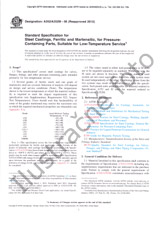Potrebujeme váš súhlas na využitie jednotlivých dát, aby sa vám okrem iného mohli ukazovať informácie týkajúce sa vašich záujmov. Súhlas udelíte kliknutím na tlačidlo „OK“.
ASTM D8491-22
Standard Test Method for Recovered Carbon Black—Rheological Non-Linearity of a Rubber Compound by Fourier Transform Rheology
NORMA vydaná dňa 1.12.2022
Informácie o norme:
Označenie normy: ASTM D8491-22
Poznámka: NEPLATNÁ
Dátum vydania normy: 1.12.2022
Kód tovaru: NS-1098661
Počet strán: 2
Približná hmotnosť: 6 g (0.01 libier)
Krajina: Americká technická norma
Kategória: Technické normy ASTM
Anotácia textu normy ASTM D8491-22 :
Keywords:
FT rheology, rCB, reinforcement, RPA,, ICS Number Code 83.060 (Rubber)
Doplňujúce informácie
| Significance and Use |
|
3.1?This test method provides a measure of rheological non-linearity for filled rubber compounds under oscillatory shear conditions: the normalized 3rd harmonic of the torque I3/1. 3.2?Rheological linearity means that the modulus is a function of frequency only. The shear modulus dependency on both frequency and amplitude of a dynamic deformation is a non-linear, rheological effect. Filled rubbers show a strain dependency of the modulus known as Payne effect. A test method for evaluating the Payne effect can be found in Test Method D8059. 3.3?One of the main contributions to the Payne effect is the so-called polymer-filler interaction in the range of mid amplitude oscillation shear, MAOS. The MAOS amplitude range is defined as the range where I1.1?This test method provides a measure of rheological non-linearity of a rubber compound filled with rCB to assess its reinforcement capabilities. This test method requires the use of a sealed cavity rotorless oscillating shear rheometer for the measurement of the torque with increasing sinusoidal strain applied to an uncured rubber compound containing significant amounts of colloidal fillers, such as recovered carbon black, alone or as blend with virgin carbon black. 1.2?UnitsThe values stated in SI units are to be regarded as the standard. No other units of measurement are included in this standard. 1.3?This standard does not purport to address all of the safety concerns, if any, associated with its use. It is the responsibility of the user of this standard to establish appropriate safety, health, and environmental practices and determine the applicability of regulatory limitations prior to use. 1.4?This international standard was developed in accordance with internationally recognized principles on standardization established in the Decision on Principles for the Development of International Standards, Guides and Recommendations issued by the World Trade Organization Technical Barriers to Trade (TBT) Committee. |




 Cookies
Cookies
